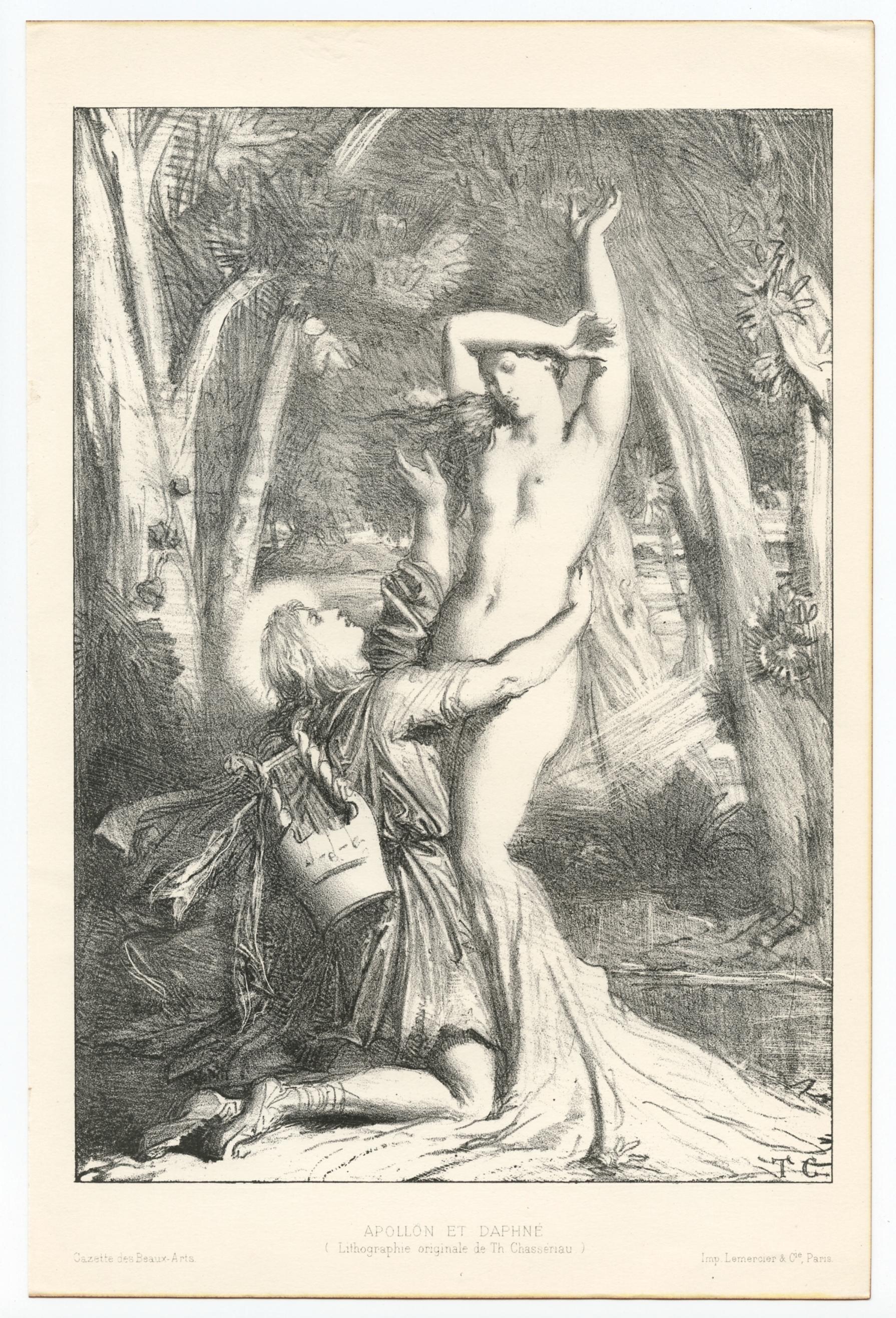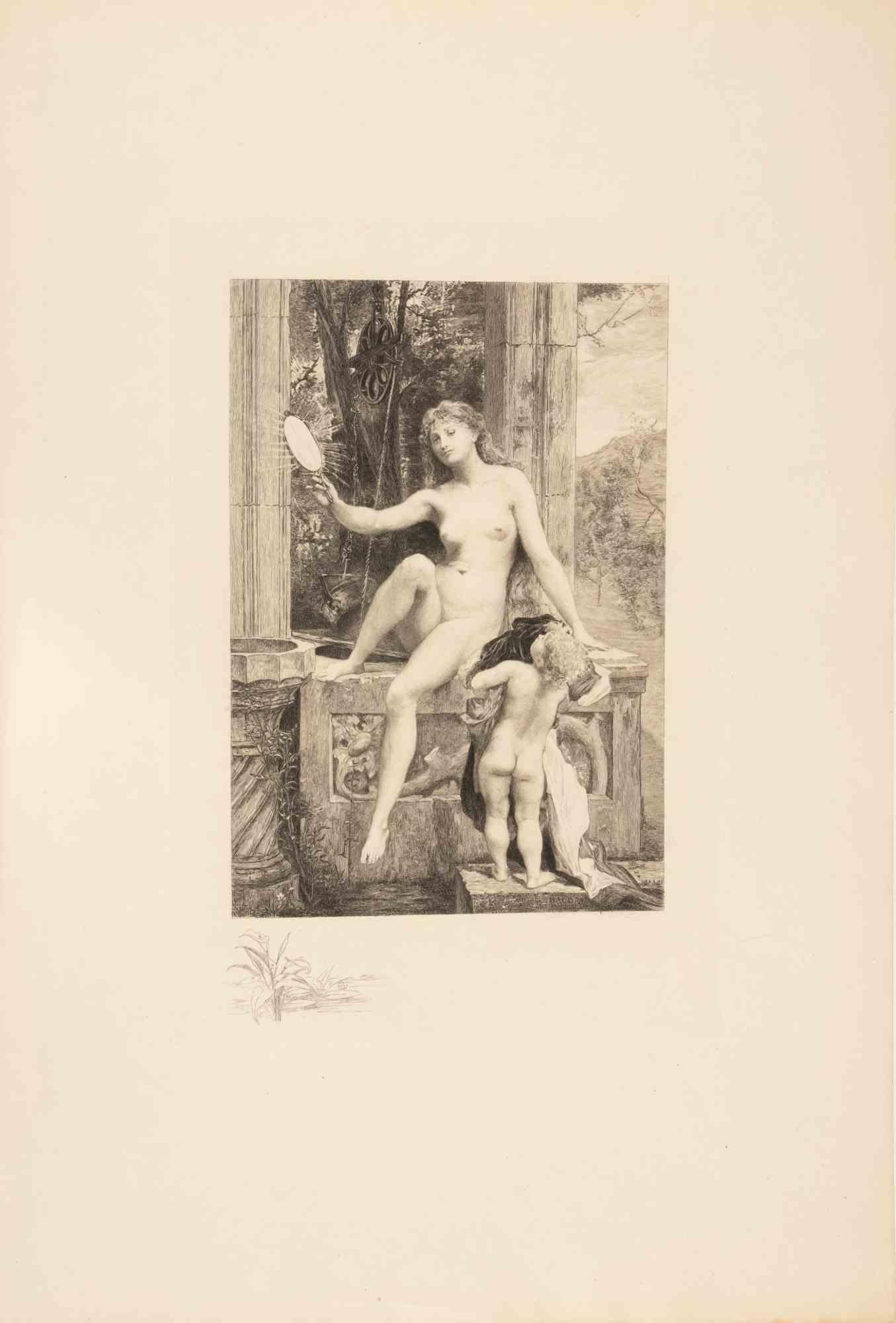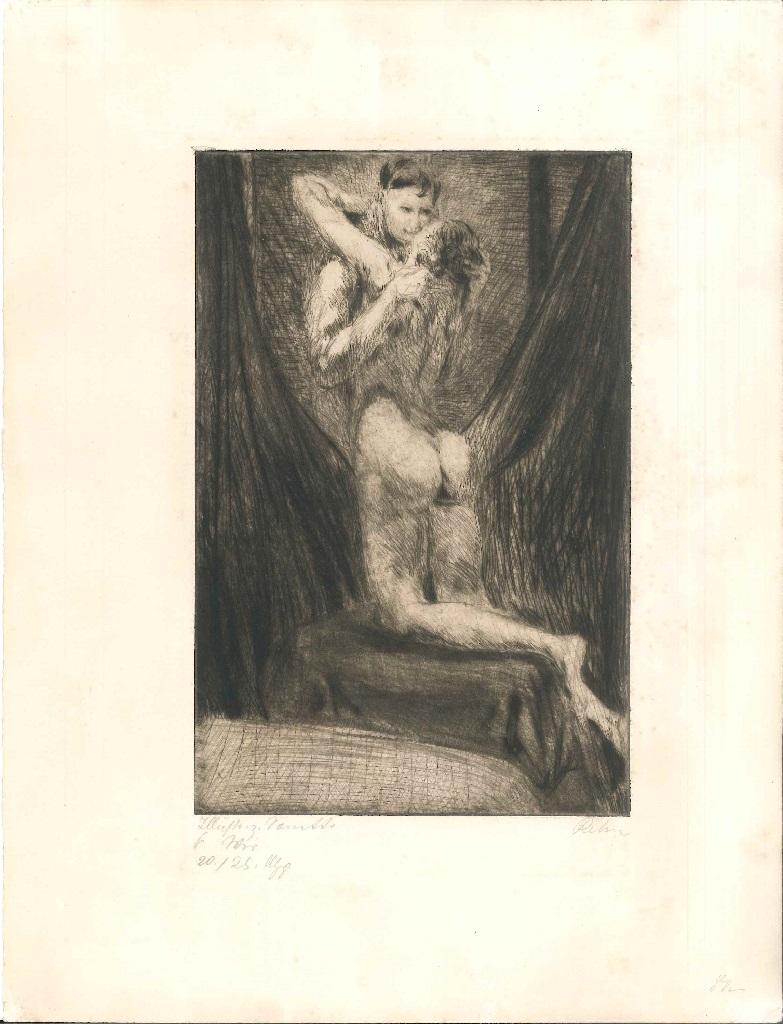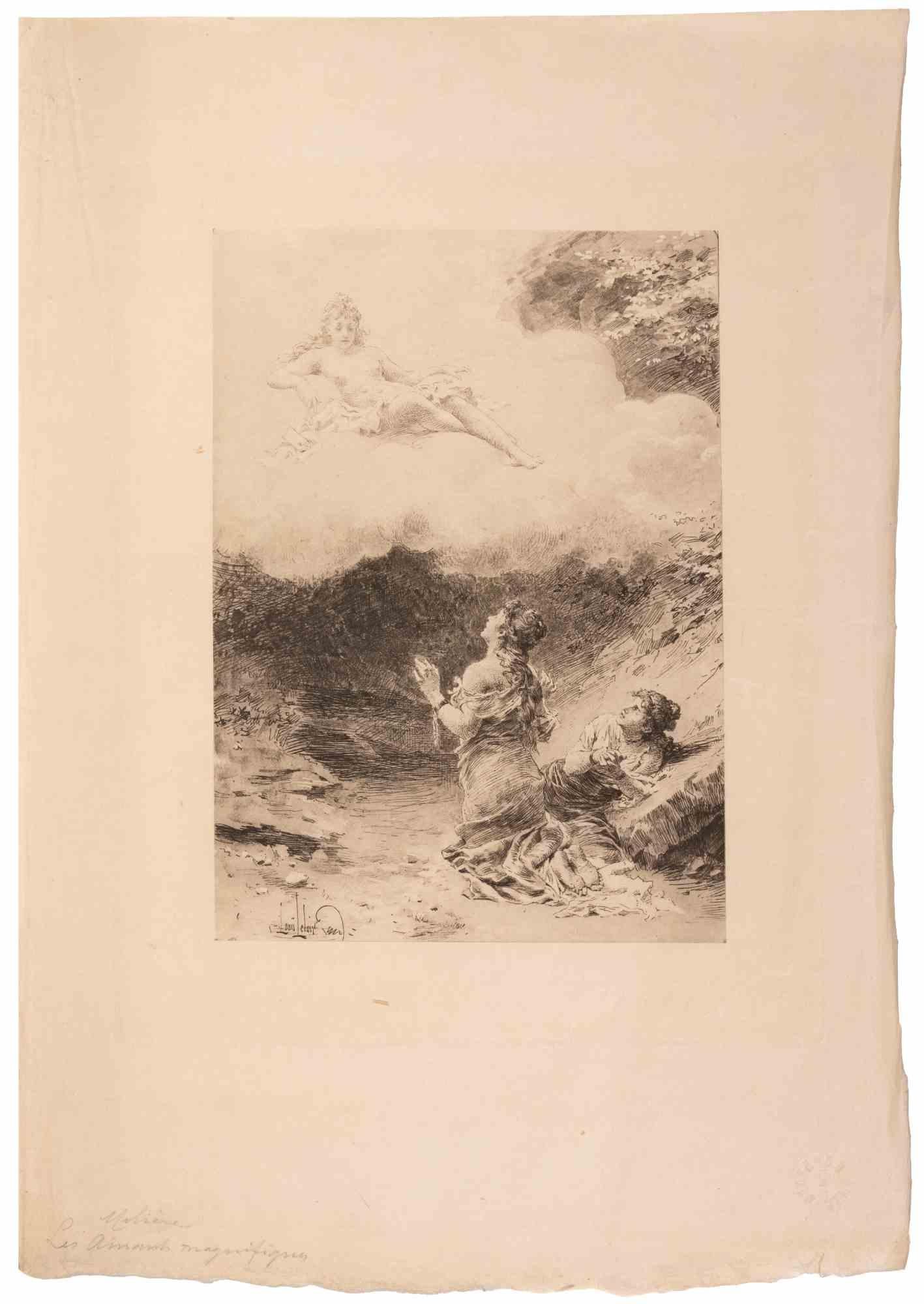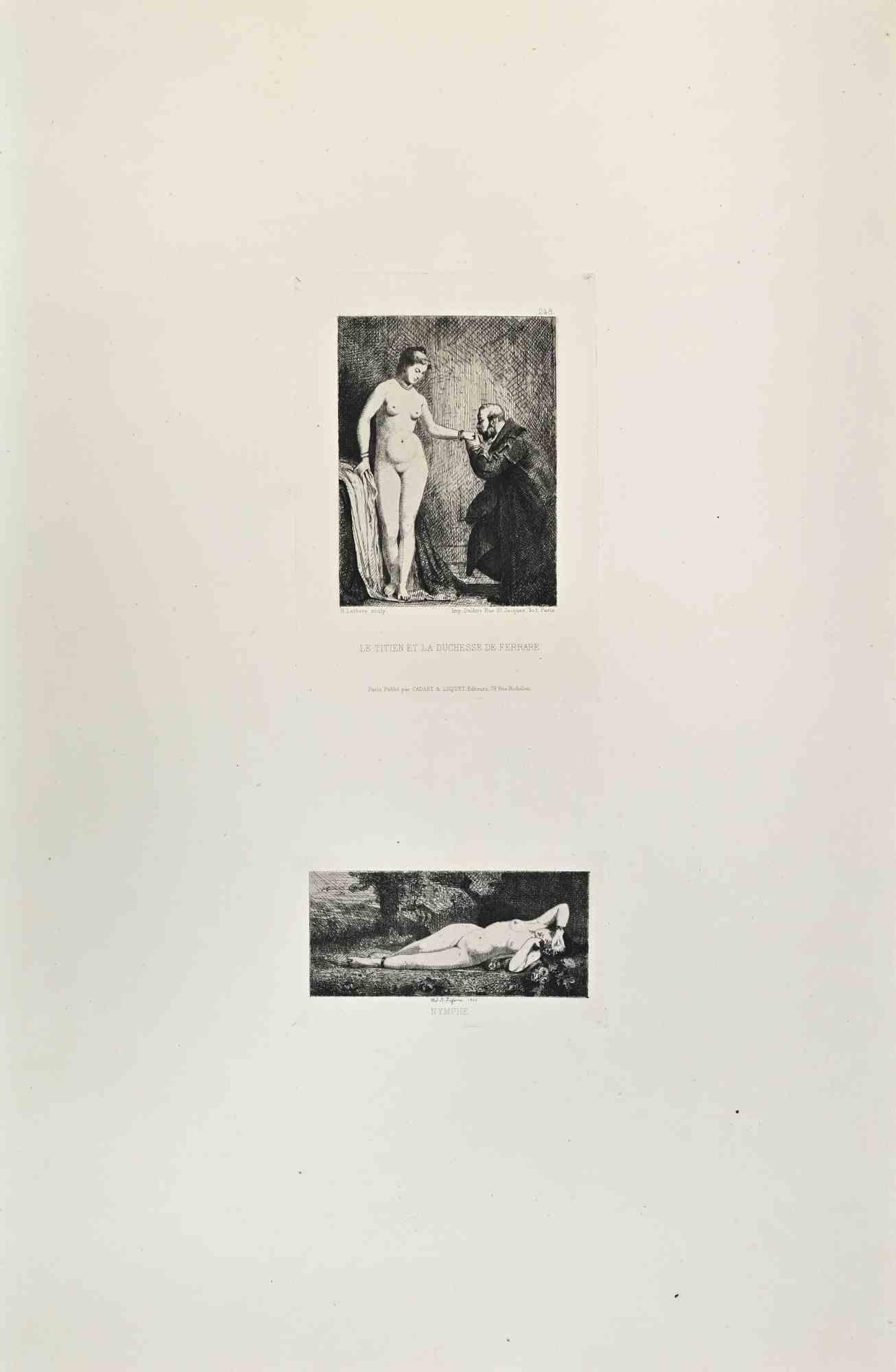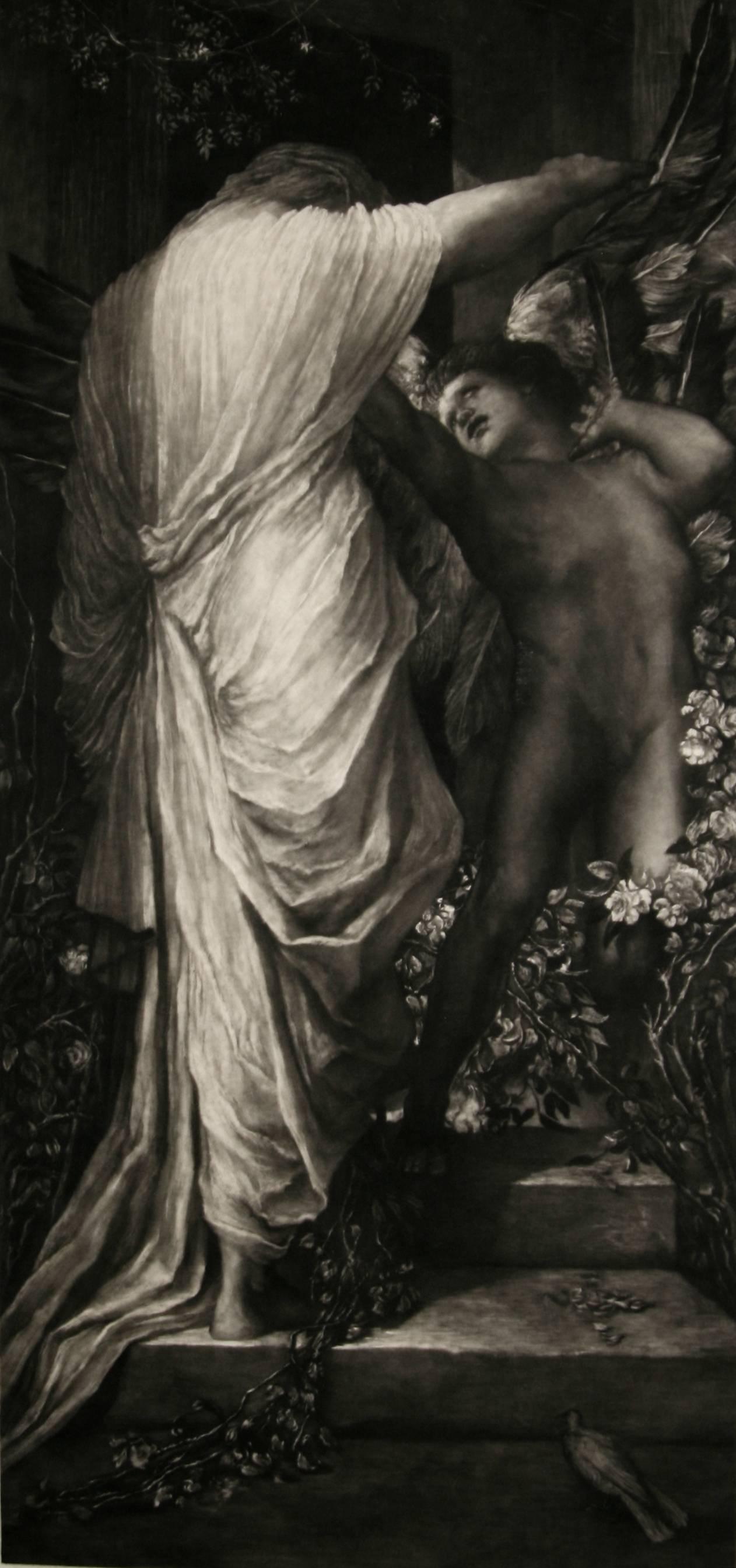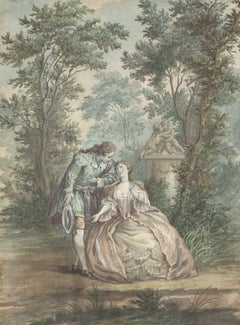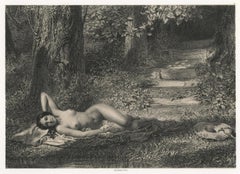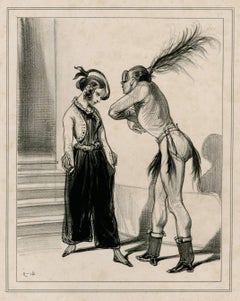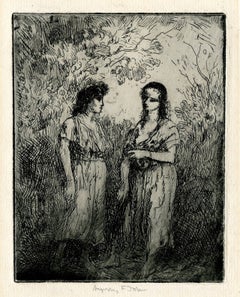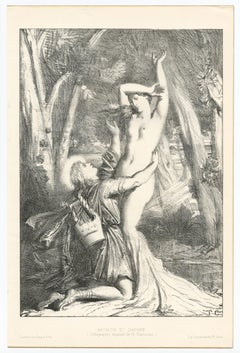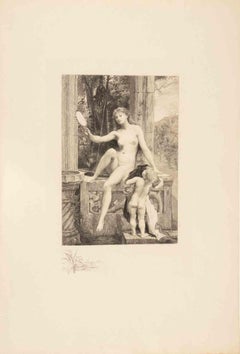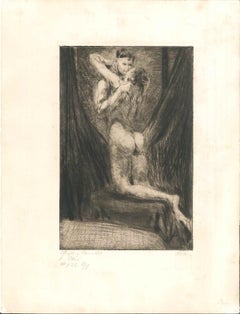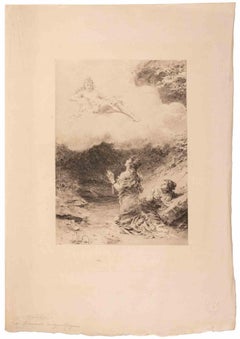Items Similar to Phrosine and Mélidore
Want more images or videos?
Request additional images or videos from the seller
1 of 5
Edouard Joseph DantanPhrosine and Mélidore1879
1879
$400
£309.38
€352.22
CA$574.34
A$627.48
CHF 328.86
MX$7,492.30
NOK 4,161.80
SEK 3,880.80
DKK 2,630.49
About the Item
Phrosine and Mélidore
Etching, 1879
Signed in the polate lower left of image
This etching is after the Dantan painting, a copy after the Pierre-Paul Prud’hom painting
Published by Vve. A. Cadart, 56, Bard. Haussman, Paris
A deluxe impression with masked letters
The Prud’hom painting is in the Musée des Beaux-AÉdouard Joseph Dantan was born on 26 August 1848 in Paris. His grandfather, who had fought in the Napoleonic Wars, was a wood sculptor. His father, Antoine Laurent Dantan, and uncle, Jean-Pierre Dantan, were both well-known sculptors.[1] Dantan was a pupil of Isidore Pils and Henri Lehmann at the École nationale supérieure des Beaux-Arts in Paris.[2] At the age of nineteen he won a commission for a large mural painting of The Holy Trinity for the Hospice Brezin at Marne (Seine-et-Oise).[3] Dantan's first exhibit at the Paris Salon was An Episode in the Destruction of Pompeii in 1869. In 1870 the Franco-Prussian War interrupted his work, and he enlisted in the defence force.[4] He was given the rank of a sergeant, and was later promoted to lieutenant.[5] During the war the family home was burned down.[4]
In the years after the war Dantan exhibited a number of other paintings at the Salon including Hercules at the Feet of Omphale (1874), Death of Tusaphane (1875), The Nymph Salmacis (1876), Priam Demanding of Achillees the Body of Hector (1877), Calling of the Apostles Peter and Andrew (1878), Corner of a Studio (1880) and The Breakfast of the Model (1881).[3] He continued to exhibit at the Salon until 1895. In 1890, 1894 and 1895 he served on the jury of the Salon.
For twelve years Dantan's companion was the model Agostina Segatori, who had also posed for artists such as Jean-Baptiste Corot, Jean-Léon Gérôme, Eugène Delacroix and Édouard Manet. She bore a child to Dantan, Jean-Pierre, in 1873. On their separation, Agostina opened Café du Tambourin on the Boulevard de Clichy that became a meeting place for artists.[6][fn 1] Dantan spent his summers in Villerville, where he died on 9 July 1897 when the carriage in which he was riding crashed violently into the village church.[8]
Style and reception
Coin d'atelier (1880)
At the 1870 exposition of the Ecole Nationale des Beaux-Arts Dantan received an honorable mention for his submission for the prix de Rome.[9] In 1874 he won a third class medal for his painting of a monk carving a Christ in wood.[10] In 1880 he won a second class medal for his painting Un coin d'atelier (a corner of the workshop).[11] He received a gold medal at the Paris Exposition of 1889,[12] and a number of his paintings were bought by the French state.
Dantan's works followed the academic tradition of painting, and were praised by his contemporaries. His technical mastery is illustrated by such paintings as Un coin d'atelier (1880), where he depicts his father working on a bas-relief in his studio, seen from behind. The studio is cluttered with paintings and sculptures. In the foreground, a nude woman is taking a break from modelling. A critic praised the painting for following all the rules of trompe-l'oeil and stereoscopic photography.[13] Describing a painting of a group of sailors following a clergyman going to bless the sea, another critic said in 1881 "he has written a page before which believers and skeptics must raise their hats".[14]
His Le déjeuner du modèle exhibited in the Salon in 1881 shows a model eating a plate of eggs in a break from the posing session. The scene is illuminated by a clear white light, with a delicate sense of reflected light. One reviewer said that Dantan had treated the subject with taste and grace, when it could easily have fallen into vulgarity.[11] He was by no means limited to one genre. Other paintings at this time included one of his mother outdoors in her invalid chair, her face sad, a pastoral portrait of a young blonde Édouard Joseprts de Bordeaux
The young Phrosine, at right, falls in love with Mélidore, but her jealous brothers separate the two and banish Mélidore to a life as a hermit on a nearby island. Desperate to see her beloved, Phrosine swims across the channel at night, and collapses, naked, into his arms.
Sheet size:15 15/16 x 11 1/8 inches
Plate size: 12 9/16 x 9 1/2 inches
From Wikipedia, the free encyclopedia
Édouard Joseph Dantan (26 August 1848 – 7 July 1897) was a French painter in the classical tradition. He was widely recognized in his day, although he was subsequently eclipsed by painters with more modern styles.
Biography
Édouard Joseph Dantan was born on 26 August 1848 in Paris. His grandfather, who had fought in the Napoleonic Wars, was a wood sculptor. His father, Antoine Laurent Dantan, and uncle, Jean-Pierre Dantan, were both well-known sculptors. Dantan was a pupil of Isidore Pils and Henri Lehmann at the École nationale supérieure des Beaux-Arts in Paris. At the age of nineteen he won a commission for a large mural painting of The Holy Trinity for the Hospice Brezin at Marne (Seine-et-Oise). Dantan's first exhibit at the Paris Salon was An Episode in the Destruction of Pompeii in 1869. In 1870 the Franco-Prussian War interrupted his work, and he enlisted in the defence force. He was given the rank of a sergeant, and was later promoted to lieutenant. During the war the family home was burned down.
In the years after the war Dantan exhibited a number of other paintings at the Salon including Hercules at the Feet of Omphale (1874), Death of Tusaphane (1875), The Nymph Salmacis (1876), Priam Demanding of Achillees the Body of Hector (1877), Calling of the Apostles Peter and Andrew (1878), Corner of a Studio (1880) and The Breakfast of the Model (1881). He continued to exhibit at the Salon until 1895. In 1890, 1894 and 1895 he served on the jury of the Salon.
For twelve years Dantan's companion was the model Agostina Segatori, who had also posed for artists such as Jean-Baptiste Corot, Jean-Léon Gérôme, Eugène Delacroix and Édouard Manet. She bore a child to Dantan, Jean-Pierre, in 1873. On their separation, Agostina opened Café du Tambourin on the Boulevard de Clichy that became a meeting place for artists. Dantan spent his summers in Villerville, where he died on 9 July 1897 when the carriage in which he was riding crashed violently into the village church.
Style and reception
At the 1870 exposition of the Ecole Nationale des Beaux-Arts Dantan received an honorable mention for his submission for the prix de Rome. In 1874 he won a third class medal for his painting of a monk carving a Christ in wood. In 1880 he won a second class medal for his painting Un coin d'atelier (a corner of the workshop). He received a gold medal at the Paris Exposition of 1889, and a number of his paintings were bought by the French state.
Dantan's works followed the academic tradition of painting, and were praised by his contemporaries. His technical mastery is illustrated by such paintings as Un coin d'atelier (1880), where he depicts his father working on a bas-relief in his studio, seen from behind. The studio is cluttered with paintings and sculptures. In the foreground, a nude woman is taking a break from modelling. A critic praised the painting for following all the rules of trompe-l'oeil and stereoscopic photography. Describing a painting of a group of sailors following a clergyman going to bless the sea, another critic said in 1881 "he has written a page before which believers and skeptics must raise their hats".
His Le déjeuner du modèle exhibited in the Salon in 1881 shows a model eating a plate of eggs in a break from the posing session. The scene is illuminated by a clear white light, with a delicate sense of reflected light. One reviewer said that Dantan had treated the subject with taste and grace, when it could easily have fallen into vulgarity. He was by no means limited to one genre. Other paintings at this time included one of his mother outdoors in her invalid chair, her face sad, a pastoral portrait of a young blonde woman in a blue dress, full of life, and of a poor fisherman dining in his miserable cabin on a piece of bread and an onion.
Later, Dantan's classical style fell out of fashion. Writing of the first exhibition of the Société Nationale des Beaux-Arts in the Champ de Mars in 1890, Walter Sickert was scathingly critical of most of the paintings, making exceptions for a series of far-eastern landscapes by Louis-Jules Dumoulin, a painting by Édouard Manet, some portraits by Jules-Élie Delaunay and some studies by Dantan. He praised Dumoulin as a master, described Manet's work as brilliant and powerful, Delaunay's as respectable and Dantan's as conscientious.
Major works
Fête Foraine de Saint-Cloud (1879)
Un Coin du Salon en 1880
At first, Dantan's subjects were mainly drawn from classical mythology or religious subjects, as was common in his day. Later he made a number of paintings of scenes from sculpture workshops, familiar from his childhood. He also painted portraits and views of Villerville.
1869 Episode of the destruction of Pompeii
1872 The Trinity, chapel of the Hospital in Brezen-on-the-Marne
1872 Portrait His father, working on a marble bust
1874 Hercules at the feet of Omphale
1874 A monk as a wood sculptor, Musée des Beaux-Arts de Nantes
1875 The Quoit-Thrower, Musée des Beaux-Arts de Rouen, Rouen
1876 The Nymph Salmacis
1878 Phrosine et Mélidore after Pierre Paul Prud'hon, Musée des Beaux-Arts de Bordeaux
1879 Fête Foraine de Saint-Cloud
1880 Christ on the Cross, Church of Dombrowa, Poland
1880 Un Coin d'atelier, Paris, Palais du Luxembourg (filed in 1925, not found in 1977)
1880 Un Coin du Salon de 1880 (sale Sotheby's New York, 24 May 1995)
1881 Le déjeuner du modèle
1882 Corpus Christi Day
1884 Burial of a child, Villerville, Musée Malraux, Le Havre
1885 Shooting their nets
1886 Entracte Un à la Comedie-Francaise de première un soir, en 1885, Comédie-Française, Paris
1887 Un moulage sur Nature, Konstmuseum Gothenburg, Gothenburg
1887 L'Atelier du sculptor
About the Seller
5.0
Recognized Seller
These prestigious sellers are industry leaders and represent the highest echelon for item quality and design.
Gold Seller
Premium sellers maintaining a 4.3+ rating and 24-hour response times
Established in 1978
1stDibs seller since 2013
827 sales on 1stDibs
Typical response time: <1 hour
Associations
International Fine Print Dealers Association
- ShippingRetrieving quote...Shipping from: Akron, OH
- Return Policy
More From This Seller
View AllAmorous Couple
By Philibert-Louis Debucourt
Located in Fairlawn, OH
Amorous Couple
Watercolor on laid paper, c. 1810
Unsigned
Provenance: Emile Wolf (1899-1996)
The art collection of Emile Wolf was dispersed by Sotheby and Stair Galleries.
Condition: Excellent
22K gold leaf finishes corner frame (see photo)
“Mr. Wolf’s collection reflects a lifelong commitment to the arts. Although a mainstay of the Old Masters art scene in New York, Mr. Wolf’s collection spanned centuries and genres. He was an impassioned collector, and his Fifth Avenue apartment was filled with paintings and drawings that hung from floor to ceiling in every room. Space void of art was lined with an extensive library of art books that fueled his ardent collecting. Mr. Wolf took great joy in sharing this collection and his ideas with art historians, collectors, dealers and university students.
The Wolf collection included masterworks from every influential and groundbreaking Impressionist and modern artist of the late 19th and early 20th centuries, ranging from an outstanding grouping of works on paper by Picasso, Pissarro, and Cezanne to a Renoir oil...
Category
1810s Romantic Figurative Drawings and Watercolors
Materials
Watercolor
La Sortie du Bain
Located in Fairlawn, OH
Eugene Leroux (1807-1863)
La Sortie Du Bain
Lithograph, c. 1840
Signed in the lower left corner of the image (see photo)
Inscribed "Imp Bertauts Paris" in bottom margin
Inscribed "55...
Category
1840s Romantic Nude Prints
Materials
Lithograph
"Do you wish to escape, my wild one"
By Paul Gavarni
Located in Fairlawn, OH
Unsigned
Edition: 12 (proof before lettering)
Provenance:
Charles Sessler, Philadelphia
Considered by A. & B. as "rare, rare, rare."
Reference: A. & B. 256 i/II, proof...
Category
19th Century Figurative Prints
Materials
Lithograph
Pyramus and Thisbe
By Augustus Edwin John
Located in Fairlawn, OH
Pyramus and Thisbe
Etching, c.1906
Signed along bottom edge in pencil "Augustus E John"
Edition: 25
Reference: Dodgson 91 ii/II
Condition: Excellent
Plate: 5 1/8 x 4" (13.02 x 10.16 ...
Category
Early 1900s Young British Artists (YBA) Figurative Prints
Materials
Etching
Neue Träume von Glück (New Dreams of Happiness)
By Max Klinger
Located in Fairlawn, OH
Neue Träume von Glück (New Dreams of Happiness)
Etching on heavy laid paper without watermark, 1887
Unsigned, as usual
From: Eine Liebe (Opus X) [A Love (Opus X)], Plate No. 7
fourth...
Category
1880s Expressionist Nude Prints
Materials
Etching
Connais-tu le Pays (Primavera) apres J. Rolshoven (Do you Know the Country)
By Theophile Narcisse Chauvel
Located in Fairlawn, OH
Connais-tu le Pays (Primavera) apres J. Rolshoven
(Do you Know the Country -Spring)
Etching, 1889
Signed "Julius Rolshoven" in pencil...
Category
1880s Barbizon School Figurative Prints
Materials
Etching
You May Also Like
"Apollon et Daphne" original lithograph
By Théodore Chassériau
Located in Henderson, NV
Medium: original lithograph. Executed in 1844. Catalogue references: Benedicte 26 and Fisher 4. This impression on wove paper was printed by Lemercier for Gazette des Beaux-Arts. Ima...
Category
1840s Prints and Multiples
Materials
Lithograph
La Vérité - Etching by Antoine Dezarrois - 1900
Located in Roma, IT
Etching realized by Antoine Dezarrois in 1900, after P. Baudry.
Proof on Japan paper, not signed as issued.
Very good condition.
Category
Early 1900s Modern Figurative Prints
Materials
Etching
Mein Weg mit dem Weib, plate 16
By Walter Richard Rehn
Located in Roma, IT
Drypoint and aquatint (brown ink) on cream paper.
Signed "Rehn" in pencil on the lower right margin. Titled and numbered in pencil on the lower left margin. Edition of 25 prints. Fro...
Category
1910s Modern Figurative Prints
Materials
Drypoint, Aquatint
Les Amants Magnifiques - Etching by Louis Leloir - Mid-19th Century
Located in Roma, IT
Etching realized in the mid-19th Century, before the letter on Japon paper.
Not signed, as issued.
Very good condition.
Category
Mid-19th Century Modern Figurative Prints
Materials
Etching
Nymphe et le Titien et la Duchesse de Ferrare - Etching by R. Lefevre - 1870s
Located in Roma, IT
Nymphe et le Titien et la Duchesse de Ferrare is an artwork realized by R. Lefevre in the 1870s.
Etching.
Good conditions.
Realized for the "Société des Aquafortistes. Born on th...
Category
1870s Modern Figurative Prints
Materials
Etching
Love and Death.
By Sir Frank Short
Located in Storrs, CT
Love and Death (after George Frederic Watts, R.A., H.R.C.A. 1817 - 1904). 1900. Mezzotint. Hardie 71 between i and ii. 24 1/2 x 12 (sheet 27 1/4 x 13 3/ 8). Edition 350 in state one. London, Published May 1st 1900 by Robert Dunthorne ,5 Vigo Street, London W. Rubbing and discoloration from a previous mat in the margins, well outside the image. A rich proof printed on Japon paper. Signed in pencil by Watts and by Short. Housed in an archival folder
-------------------------------------------------------------------------------------------------------
Winged Love...
Category
Early 1900s Victorian Figurative Prints
Materials
Mezzotint
$1,000 Sale Price
33% Off
More Ways To Browse
Wood Monk
Christ On The Cross
Face Chairs
Church Cross
Antique Egg Plate
Antique Corpus Christi
5 Feet By 7 Feet Painting
Hercules Bust
Antique Church Cross
Antique Face Chair
Antique Invalid Chair
Skate Decks Keith Haring
Sophy Brown
Southwest Vintage Posters
Sticky Fingers Album
Sunset Peter Max
Tammy Wynette
Tarkay Lithograph
